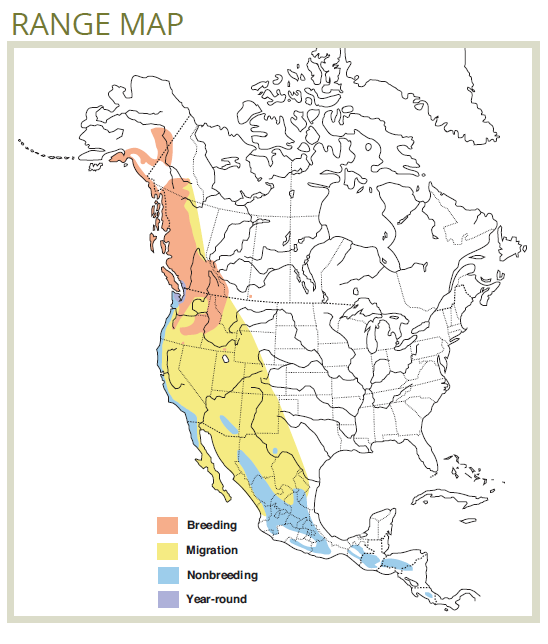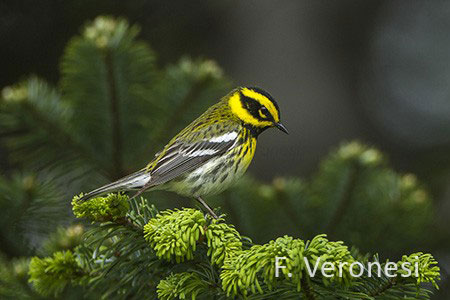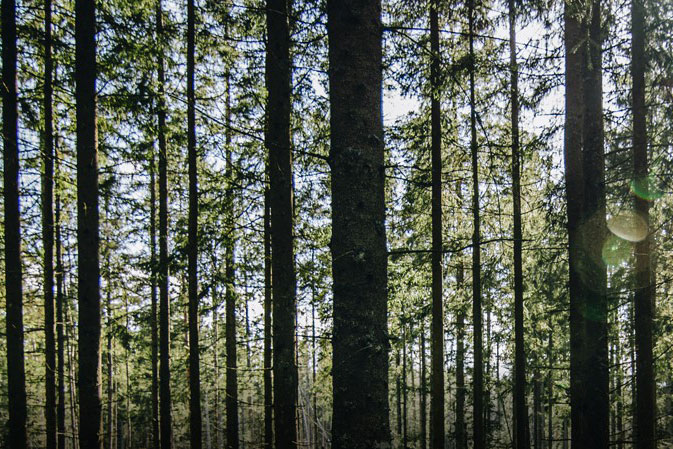The Townsend’s Warbler is a stunning songbird, yet it has been studied much less than other warblers. Its song is similar to the Black-throated Green Warbler, but with a quicker final note: “see-see-see-seeseePTCHeee”.
Townsend’s Warbler
(Setophaga townsendii)
Habitat Ecology
- The Townsend’s Warbler is found in a range of forests including mature fir in the Pacific Northwest, interior mixed conifer forests, and coniferous and mixed deciduous-coniferous interior, sub-boreal, and boreal forests.1
- This species is most strongly associated with unharvested old forests.1
- In interior mixed conifer forests, they prefer to nest where there are high volumes of grand and Douglas fir, and prefer to forage on grand fir and western larch.2
- In boreal and sub-boreal forests, they prefer to nest on large-diameter white spruce in white spruce-dominated forests. Medium-diameter spruce (15–38 cm dbh) were used for foraging and, in Alaska, alder and paper birch.3

Response to Forest Management
- While direct studies of the Townsend’s Warbler’s response to forest management are limited, their habitat associations suggest that reductions of mature and older-than-rotation forests are a threat.1
- In northern Rocky Mountain forests of the United States, they were most common in mature and old forests, and declines were attributed to harvesting.4,5
- They were, however, more abundant in logged than in burned stands in southeastern BC, with higher abundances in cutblocks with high levels of overstory conifer retention.6
Stand-level Recommendations
- Given the Townsend’s Warbler’s preferred nesting habitats, large-diameter grand fir, Douglas fir or white spruce are recommended for retention. These trees may provide suitable nesting habitat once surrounding regenerating trees reach a minimum dbh of 15 cm.
- Of these large diameter trees, trees with thick, dense foliage should be prioritized for retention as they conceal nests from predators.7
- High levels of overstory retention (e.g., up to 320 stems/ha) or high-grading are recommended in at least some harvest blocks in lieu of clearcutting or low-retention treatments.6
Landscape-level Recommendations
- While more extensive research is necessary to determine best practices at the landscape scale for the Townsend’s Warbler, recommendations for this species typically highlight the importance of large, old, conifer-dominated forest. Given the Townsend’s Warbler’s association with important merchantable species, it seems likely that representation of these stands on the landbase (e.g., extended rotation management and representation of older forests within an NRV scenario) will be an important component for their conservation, particularly if these forest types are not well-represented on the passive landbase.
References
- Wright, A. L., Hayward, G. D., Matsuoka, S. M. & Hayward, P. H. 1998. Townsend’s Warbler (Setophaga townsendi), version 2.0. in The Birds of North America (Rodewald, P. G., ed.) Cornell Lab of Ornithology, Ithaca, New York, USA. Available online: https://doi.org/10.2173/bna.333
- Mannan, R. W. & Meslow, E. C. 1984. Bird populations and vegetation characteristics in managed and old-growth forests, northeastern Oregon. The Journal of Wildlife Management 48: 1219–1238. Available online: http://www.jstor.org/stable/3801783
- Matsuoka, S. M., Handel, C. M. & Roby, D. D. 1997. Nesting ecology of Townsend’s warblers in relation to habitat characteristics in a mature boreal forest. The Condor 99: 271–281. Available online: https://sora.unm.edu/node/105247
- Hutto, R. L. & Young, J. S. 1999. Habitat relationships of landbirds in the Northern Region, USDA Forest Service. Gen. Tech. Rep. RMRS-GTR-32. U.S. Department of Agriculture, Forest Service, Rocky Mountain Research Station, Ogden, UT. 72 pp. Available online: https://www.fs.fed.us/rm/pubs/rmrs_gtr032.pdf
- Hutto, R. L., Hejl, S. J., Preston, C. R. & Finch, D. M. 1992. Effects of silvicultural treatments on forest birds in the Rocky Mountains: implications and management recommendations. Proceedings of a workshop held September 21-25, 1992, Estes Park, Colorado.
- Stuart-Smith, A. K., Hayes, J. P. & Schieck, J. 2006. The influence of wildfire, logging and residual tree density on bird communities in the northern Rocky Mountains. Forest Ecology and Management 231: 1–17.
- Matsuoka, S. M. et al. 2010. Nesting Ecology of the Rusty Blackbird in Alaska and Canada. The Condor 112: 810–824. Available online: https://doi.org/10.1525/cond.2010.100149








